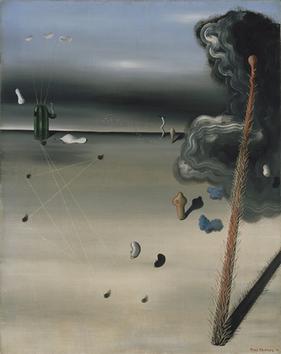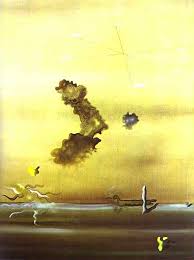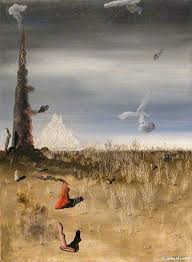Early Life
Yves Tanguy (1900-55) was a French surrealist painter. He spent his first eight years in Paris, but when his father passed away in 1908, Tanguy moved to Locronan with his mother and spent most of his childhood living with various relatives.
When he turned 18, Tanguy joined the merchant navy for a short while before being drafted into the Army, where he befriended Jacques Prévert. In 1922, he returned to Paris, where he worked anywhere he could. When he stumbled upon a painting by Giorgio de Chirico, he was so filled with awe that he was inspired to pursue painting himself despite his lack of training.

Beginnings
Tanguy had a unique method of creating his artwork in which he focused deeply on strictly one painting at a time. His very small studio only had room to hold one wet piece at a time, so this spacial constraint might have induced his working habits.
In 1924, Tanguy joined the circle of surrealist artists formed around André Breton. He quickly developed his own unique painting style, and gave his first solo exhibition in Paris in 1927. He also married his first wife Jeannette Ducrocq in the same year.

Tanguy struggled throughout the 1930s as did many other artists. His dire financial situation ultimately led to the failure of his first marriage. In 1938, Tanguy had an affair with Peggy Guggenheim when he went to London with his wife to hang his first retrospective exhibition in Britain at her gallery Guggenheim Jeune. The exhibition was a great success, and his affair with Guggenheim would only end when he met the surrealist artist Kay Sage who would become his second wife.

Later Life
Tanguy was judged unfit for service in WWII, and he and Sage moved together to New York. They were married in 1940, and at the end of the war they moved to Woodbury, Connecticut, converting an old farmhouse into an artists’ studio. In 1948, Tanguy became citizen of the United States and would stay in the US for the rest of his life. In 1955, Tanguy died of a stroke. His ashes were scattered with his wife’s in 1963.

Style and Impact
Tanguy’s style is one of unique, recognizable nonrepresentational surrealism. His paintings feature vast, abstract landscapes painted in a very limited palette of colors, with only the occasional flashes of contrasting color accents. Abstract shapes and forms, which are sometimes angular and sharp, sometimes eerily organic crowd his landscapes. Tanguy’s distinctive style deeply influenced younger painters such as Wolfgang Paalen, Roberto Matta and Esteban Francés. Tanguy’s paintings also influenced the style of the French animated movie Le Roi et l’oiseau, by Paul Grimault and Jacques Prevert.

(I apologize about the size of the images! I really couldn’t find any bigger ones!)
Cited:
‘Wikipedia, Yves Tanguy: https://en.m.wikipedia.org/wiki/Yves_Tanguy
Guggenheim: Yves Tanguy: https://www.guggenheim.org/artwork/artist/yves-tanguy
Tate: Yves Tanguy: https://www.tate.org.uk/art/artists/yves-tanguy-2023
WikiArt: Yves Tanguy:https://www.wikiart.org/en/yves-tanguy
Coralie,
Very impressed with your choices in artists (Redon, Derain, and Tanguy) and your writing. Your research is stellar and they are a pleasure to read. Your enthusiasm for the painters you post on comes through brilliantly. Keep up your good work here.
Jeff